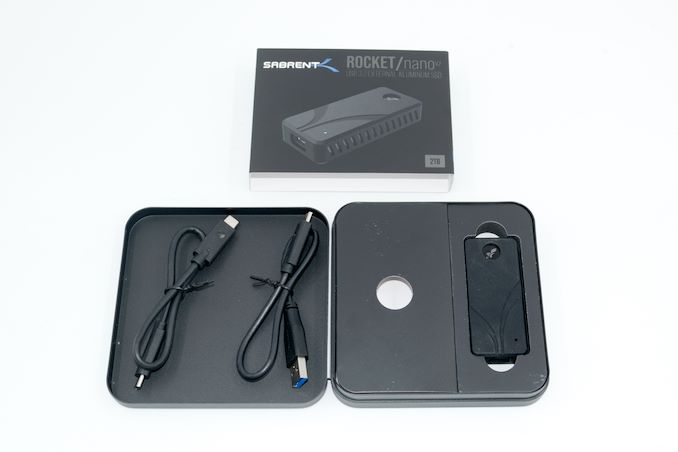Sabrent’s lineup of internal and external SSDs is popular among enthusiasts. The primary reason is the company’s tendency to be among the first to market with products based on the latest controllers, while also delivering an excellent value proposition. The company has a long-standing relationship with Phison and adopts its controllers for many of their products. The company’s 2 GBps-class portable SSD – the Rocket nano V2 – is based on Phison’s U18 native controller and has been available in the market for well over a year now.
This review takes a detailed look at the Rocket nano V2 External SSD, including an analysis of its performance consistency, power consumption, and thermal profile.
Introduction and Product Impressions
Rapid advancements in flash technology (including the development of 3D NAND and improvements in TLC reliability) have been accompanied by the appearance of faster host interfaces for external devices in the last decade. Together, they have contributed to bus-powered direct-attached storage devices growing in both storage capacity and speeds. The Type-C standard has also achieved widespread acceptance in the consumer market. Protocols such as USB 3.2 Gen 2×2 / USB4 and Thunderbolt riding on top of the Type-C connector have enabled the introduction of palm-sized flash-based storage devices capable of delivering 2 GBps+ speeds.
One of the primary challenges with high-speed storage devices is the thermal aspect. Bridge-based solutions with multiple protocol conversion chips tend to dissipate more power due to the additional components. High-performance portable SSDs in the past have had no option but to use them – first, with SATA bridges, and then with NVMe bridges. The introduction of native UFD controllers capable of hitting 10 Gbps and 20 Gbps from Phison and Silicon Motion has opened up yet another option in this category. The Crucial X6, equipped with the Phison U17, was reviewed in August 2021 and was one of the first retail products to surpass the SATA speeds barrier by hitting 800 MBps speeds without using an NVMe bridge. Around the same time, Silicon Motion’s SM2320 powered the Kingston XS2000 to 2 GBps speeds without a bridge in the middle.
Products based on Silicon Motion’s SM2320 have gained a lot of consumer mindshare because they have typically been able to hit the interface speed limits for sequential accesses in both the 10 Gbps and 20 Gbps categories. Phison’s U17 and U18 were introduced with slightly lower peak performance numbers, and despite vendors like Crucial picking them up for the X6, the products didn’t make any waves. The best implementation of Phison’s U17, in our opinion, was seen in the OWC Envoy Pro Mini. The introduction of faster flash has since allowed portable SSDs (PSSDs) based on Phison’s native UFD controllers to hit higher speeds. As a result, we have seen an uptick in their adoption. Products such as the PNY EliteX-PRO, Sabrent Rocket Nano v2, and the Corsair EX100U are based on the Phison U18 controller. The EliteX-PRO’s performance was nothing to write home about. We reached out to Sabrent for a sample of the Rocket nano V2 to determine if it could be the ‘OWC Envoy Pro Mini equivalent’ for the U18 controller.
The PNY EliteX-PRO, Corsair EX100U, and the Sabrent Rocket nano V2 all use the same hardware platform – Phison’s U18 controller with 128L 3D TLC NAND from SK hynix. However, the firmware configuration, thermal solution, and case design are significantly different.
The Rocket nano V2 is small at approx. 72mm x 32mm x 14mm, but has a solid feel to it, thanks to its aluminum construction and 50g weight. The drive has a silicone cover that lends it protection against dents and scratches on the metal segment while also providing for a limited amount of ruggedness.
The Rocket nano V2 supports S.M.A.R.T passthrough, as shown in the CrystalDiskInfo screenshots below. Despite TRIM not being noted in the features list, we found an NTFS volume on the PSSD successfully processing TRIM commands from Windows. All S.M.A.R.T features such as temperature read outs worked well.
| S.M.A.R.T Passthrough – CrystalDiskInfo | |
 |  |
The table below presents a comparative view of the specifications of the different portable SSDs presented in this review.
| Comparative Direct-Attached Storage Devices Configuration | ||
| Aspect | ||
| Downstream Port | Native Flash | Native Flash |
| Upstream Port | USB 3.2 Gen 2×2 Type-C | USB 3.2 Gen 2×2 Type-C (Female) |
| Bridge Chip | Phison U18 | Silicon Motion SM2320 |
| Power | Bus Powered | Bus Powered |
| Use Case | Compact and rugged 2GBps-class portable SSD in a pocketable form-factor | 2GBps-class, IP66-rated, rugged palm-sized high-performance portable SSD with hardware encryption and a Type-C interface |
| Physical Dimensions | 72.4 mm x 32.5 mm x 14.5 mm | 86.2 mm x 54.4 mm x 13.2 mm |
| Weight | 50 grams (without cable) | 80 grams |
| Cable | 30 cm USB 3.2 Gen 2×2 Type-C to Type-C 30 cm USB 3.2 Gen 2 Type-C to Type-A | 30 cm USB 3.2 Gen 2 Type-C to Type-C Attached Type-C female to Type-A male adapter (resultant Type-C to Type-A cable length : 31.8 cm) |
| S.M.A.R.T Passthrough | Yes | Yes |
| UASP Support | Yes | Yes |




